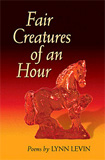March 5, 2010FAIR CREATURE OF AN HOUR
Review by Rob Wright
Loonfeather Press
P.O. Box 1212
Bemidji, MN 56619
ISBN 978-0-926147-28-7
2009, 74 pp., $12.95
www.loonfeatherpress.com
What is a “fair creature of an hour?” The title of Lynn Levin’s new poetry collection suggests ephemerality. In the case of the sonnet from which the title is taken, it’s the end of Keats’ experience of the world, of fair creatures. By the end of Lynn Levin’s collection I was convinced that there were other sorts of “fair creatures”: a race horse whose fame ended when he won two, but failed to take the third race of the Triple Crown, and a soul that just looked death in face.
Sadly, poems themselves are often ephemeral. How long does a poem stay with us on a casual reading? An hour? True, most of us can bring to mind phrases and images from poems we know and love, but for the most part, poems are only briefly held in our minds and are transient, like the thistledown which is the title of one of my favorite of Levin’s poems from this collection. Friends are arguing about the nature of the soul when a car—a Vauxhall, setting the scene in England—races toward them “on the wrong side of the road,” almost bringing on their deaths. The poet wonders if the soul is not “perishable? Organically based?” By the poem’s end, the friends who have “gulped back our ghosts” after fast action by the driver are now “spinning, laughing, waving their arms” in a field of thistledown that sticks to their clothes. It is moments like these, testifying to the joy of observation and survival that appear again and again in this collection and stay with me.
Lynn Levin has divided her book into four parts with notes at the end. The poems are almost without exception free verse, except for a sonnet titled “Freefall” and a triolet “For the Red Planet.” The formal device of alternating iambic with trochaic lines gives “In the Alte Pinkothek” a pleasant rambling rhythm suitable for wandering around a museum. Although the first sections poems seem to me grouped by observation, by a rather original eye, the second section’s images and narratives are grounded firmly in religion. Ideas are taken from the books of the Bible, like the witty “Numbers,“ and from tradition, like the search for the hidden matzoh in “What You’re Looking For.” By tradition, the collection’s notes tell us, a piece of ceremonial bread is hidden during the Seder, the meal honoring deliverance. The poet wonders if the bread is hidden “between old LPs / after a certain decimal of pi,” then wonders what to do with it once it has been found: “be able to read its Braille / play its sheet music, / want to eat it.” It’s typical of this poet to think of the most obvious thing last. But to be able to read the Braille of a matzoh is an astonishing idea. What would the poet, or her readers find in the bread baked for a ceremony of deliverance: history, tragedy, survival? I love the idea later suggested that there are those who “hope never to find it / fearing that once in hand / the thing might crack / or loose the charm.” How much like the creation of a poem, or any work of art that is. The artist asks herself, “Will this hang together? Where is it going?”
In Lynn Levin’s poems the reader gets to witness the exploration of seeing a poem travel to strange and unexpected places, as in the earlier mentioned poem “Numbers,” which she begins by speculating on the mistranslation of a passage from the book of Numbers as red heifer rather than, as it should be, a red herring. The poet moves on to what would happen if we had two toes like sloths. Would the year two-thousand be meaningless? She then imagines humans condemned to “hang / upside-down by our nails in a rain forest” and how we would lose all sense of humor and irony, but would “think the sky had wings.” Here “Numbers” is not only the fourth book of the Bible, but counted years and the digits on our hands. The imagination of the poet (and the reader) ranges, but returns again to the touchstone of the red herring, the quirk, the trick of translation. The poet does not only see the world around her in a surprising and original way, but watches the way her own mind works to produce those quirks and red herrings, which testifies to a great originality. In “Sybarite,” the poet confesses that it “was for lack of shelter/but for love of hedgerows/ that I stood in the rain.” And later, ”I rarely thought/of the way all things/stream headlong to disorder,” evoking a confidence in her own love of experience and a willful disregard for the threat of chaos around her—two charms, or faults that I cheerfully admit sharing with her.
I find the title of this collection ironic. But the irony comes from the poet’s testimony of survival rather than that of ephemerality of poetry and life. Survival of the poet’s words and ideas, and indeed the poet herself comes through memory, observance of tradition and the very human need to imagine, to turn potential tragedy into joy. For me, survival is the theme that runs through these poems and lifts them beyond the experience of the transient, of an hour.